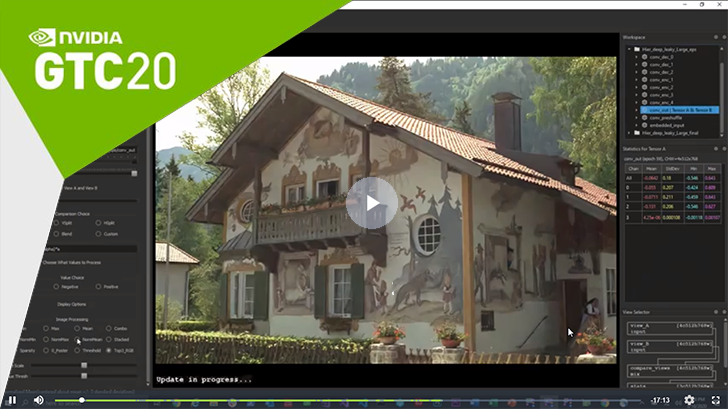Feature Map Explorer
Feature Map Explorer (FME) enables visualization of 4-dimensional image-based feature map data using a range of views, from low-level channel visualizations to detailed numerical information about each channel slice. Think of this as a way to peer into the DNN processing “black box” to find intimate information about what the model is learning, where the model is failing to use resources efficiently, and what is changing as a model is learning during training to better process data handed to it.
Download Now
FME 2022.1 Updates
- We improved the performance of loading tensor data from numpy files.
- We added an option to display channel values of literal 0 as blue to help distinguish from low-magnitude values that are non-zero, where this distinction is especially useful after ReLU activation or when comparing two tensors.
- We added an option to display FP16 safe regions that help users to spot tensor values that are susceptible to precision loss when converted to FP16 format.
- We added a right-click context menu for the main viewing region.
- We added a Percent 0 column to the tensor stats view.
- We added an option to display channel numbers in the channel views.
Visualize Feature Maps at Multiple Levels
A range of analysis data is generated, including low-level channel visualizations and detailed numerical information about the full feature map tensor and each channel slice.
Check for Opportunities to Improve Speed
FME makes it straightforward to know when you can drop to lower precision numerical formats.
Understand Training Progressions
Comparison of feature maps from one epoch to another is made easy and flexible.
Compatible with Any Training Network
Works with feature map data (stored in standard numpy .npy files) that is available from any training network.
Dive Into Each Channel
Deep learning models consist of many layers of processing, arranged as a computation graph, where the output from one layer serves as input to subsequent layers. Deep learning developers can visualize and examine each channel to see what has been learned or what is missing in a feature.


Compare Feature Maps
By providing a fast way to visually inspect the processing taking place across the layers of a DL model, the DL developer is efficiently informed about where the model is performing well and where it is falling short. This, in turn, can be used to help guide changes to the model or other training-time parameters in order to improve overall quality.
Get Better Inference Results
Understanding what can be found inside the feature maps of a network model provides a lot of information about the efficiency (and potential deficiencies) of that model, while also providing clues about how the model (or related training parameters) can be optimized to get better inference results.

How it Works

GTC Talk: Interactive Deep Learning: Using the GPU for Visual Insight into Training and Inference [S21313]
Developer Benefits
- Visualize feature maps at multiple levels
- Explore rich set of data processing options to help highlight points of interest from a feature map
- Easy and flexible comparisons of feature maps to help understand training progressions
- Find opportunities to improve speed by dropping to lower precision numerical formats
FAQ
A: Feature Map Explorer provides a way to use the power of the GPU to visualize feature map data in a fluid, interactive fashion, from a range of summary views to lower-level channel visualizations to providing detailed numerical information about each channel slice. Think of this as a way to peer into the DL processing “black box” to find intimate information about what the model is learning, where the model is failing to use resources efficiently, and what is changing as a model is learning to better process data handed to it.
A: By providing a fast way to visually inspect the processing taking place across the layers of a DL model, the DL developer is efficiently informed about where the model is performing well and where it is falling short. This, in turn, can be used to help guide changes to the model or other training-time parameters in order to improve overall quality. In this manner, Feature Map Explorer is similar to a traditional debugger, where the ability to inspect runtime state is a valuable tool in any developer’s toolbox.
A: Exploring feature maps is not a new concept, but Feature Map Explorer takes what used to be a slow, tedious process and makes it fast and efficient by leveraging GPU processing to visualize what is contained in the large feature map tensors.
Ready to try FME?
Download Now